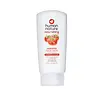What's inside
What's inside
 Key Ingredients
Key Ingredients

 Benefits
Benefits

 Concerns
Concerns

 Ingredients Side-by-side
Ingredients Side-by-side

Water
Skin ConditioningDecyl Glucoside
CleansingCoco-Glucoside
CleansingGlycerin
HumectantSolanum Lycopersicum Fruit Extract
AntioxidantCarrageenan
Tocopherol
AntioxidantSodium Lactate
BufferingSodium Gluconate
Skin ConditioningDicaprylyl Ether
EmollientGlyceryl Oleate
EmollientHydrogenated Palm Glycerides Citrate
EmollientParfum
MaskingLevulinic Acid
PerfumingSodium Levulinate
Skin ConditioningPhytic Acid
P-Anisic Acid
MaskingCitric Acid
BufferingBenzoic Acid
MaskingWater, Decyl Glucoside, Coco-Glucoside, Glycerin, Solanum Lycopersicum Fruit Extract, Carrageenan, Tocopherol, Sodium Lactate, Sodium Gluconate, Dicaprylyl Ether, Glyceryl Oleate, Hydrogenated Palm Glycerides Citrate, Parfum, Levulinic Acid, Sodium Levulinate, Phytic Acid, P-Anisic Acid, Citric Acid, Benzoic Acid
Water
Skin ConditioningSodium C14-16 Olefin Sulfonate
CleansingSorbitol
HumectantCocamidopropyl Betaine
CleansingAcrylates Copolymer
Camellia Sinensis Leaf Extract
Antimicrobial1,2-Hexanediol
Skin ConditioningCeramide AP
Skin ConditioningCholesterol
EmollientPhytosphingosine
Skin ConditioningSodium Stearoyl Lactylate
EmulsifyingXanthan Gum
EmulsifyingCarbomer
Emulsion StabilisingPentylene Glycol
Skin ConditioningGlycerin
HumectantFructose
HumectantUrea
BufferingCitric Acid
BufferingSodium Hydroxide
BufferingMaltose
MaskingSodium PCA
HumectantSodium Chloride
MaskingSodium Lactate
BufferingTrehalose
HumectantAllantoin
Skin ConditioningSodium Hyaluronate
HumectantGlucose
HumectantLactose
HumectantHydroxypropyl Methylcellulose
Emulsion StabilisingJojoba Esters
EmollientTocopheryl Acetate
AntioxidantAscorbyl Palmitate
AntioxidantUltramarines
Parfum
MaskingGluconolactone
Skin ConditioningSodium Benzoate
MaskingDisodium EDTA
Water, Sodium C14-16 Olefin Sulfonate, Sorbitol, Cocamidopropyl Betaine, Acrylates Copolymer, Camellia Sinensis Leaf Extract, 1,2-Hexanediol, Ceramide AP, Cholesterol, Phytosphingosine, Sodium Stearoyl Lactylate, Xanthan Gum, Carbomer, Pentylene Glycol, Glycerin, Fructose, Urea, Citric Acid, Sodium Hydroxide, Maltose, Sodium PCA, Sodium Chloride, Sodium Lactate, Trehalose, Allantoin, Sodium Hyaluronate, Glucose, Lactose, Hydroxypropyl Methylcellulose, Jojoba Esters, Tocopheryl Acetate, Ascorbyl Palmitate, Ultramarines, Parfum, Gluconolactone, Sodium Benzoate, Disodium EDTA
 Reviews
Reviews

Ingredients Explained
These ingredients are found in both products.
Ingredients higher up in an ingredient list are typically present in a larger amount.
Citric Acid is an alpha hydroxy acid (AHA) naturally found in citrus fruits like oranges, lemons, and limes.
Like other AHAs, citric acid can exfoliate skin by breaking down the bonds that hold dead skin cells together. This helps reveal smoother and brighter skin underneath.
However, this exfoliating effect only happens at high concentrations (20%) which can be hard to find in cosmetic products.
Due to this, citric acid is usually included in small amounts as a pH adjuster. This helps keep products slightly more acidic and compatible with skin's natural pH.
In skincare formulas, citric acid can:
While it can provide some skin benefits, research shows lactic acid and glycolic acid are generally more effective and less irritating exfoliants.
Most citric acid used in skincare today is made by fermenting sugars (usually from molasses). This synthetic version is identical to the natural citrus form but easier to stabilize and use in formulations.
Read more about some other popular AHA's here:
Learn more about Citric AcidGlycerin is already naturally found in your skin. It helps moisturize and protect your skin.
A study from 2016 found glycerin to be more effective as a humectant than AHAs and hyaluronic acid.
As a humectant, it helps the skin stay hydrated by pulling moisture to your skin. The low molecular weight of glycerin allows it to pull moisture into the deeper layers of your skin.
Hydrated skin improves your skin barrier; Your skin barrier helps protect against irritants and bacteria.
Glycerin has also been found to have antimicrobial and antiviral properties. Due to these properties, glycerin is often used in wound and burn treatments.
In cosmetics, glycerin is usually derived from plants such as soybean or palm. However, it can also be sourced from animals, such as tallow or animal fat.
This ingredient is organic, colorless, odorless, and non-toxic.
Glycerin is the name for this ingredient in American English. British English uses Glycerol/Glycerine.
Learn more about GlycerinParfum is a catch-all term for an ingredient or more that is used to give a scent to products.
Also called "fragrance", this ingredient can be a blend of hundreds of chemicals or plant oils. This means every product with "fragrance" or "parfum" in the ingredients list is a different mixture.
For instance, Habanolide is a proprietary trade name for a specific aroma chemical. When used as a fragrance ingredient in cosmetics, most aroma chemicals fall under the broad labeling category of “FRAGRANCE” or “PARFUM” according to EU and US regulations.
The term 'parfum' or 'fragrance' is not regulated in many countries. In many cases, it is up to the brand to define this term.
For instance, many brands choose to label themselves as "fragrance-free" because they are not using synthetic fragrances. However, their products may still contain ingredients such as essential oils that are considered a fragrance by INCI standards.
One example is Calendula flower extract. Calendula is an essential oil that still imparts a scent or 'fragrance'.
Depending on the blend, the ingredients in the mixture can cause allergies and sensitivities on the skin. Some ingredients that are known EU allergens include linalool and citronellol.
Parfum can also be used to mask or cover an unpleasant scent.
The bottom line is: not all fragrances/parfum/ingredients are created equally. If you are worried about fragrances, we recommend taking a closer look at an ingredient. And of course, we always recommend speaking with a professional.
Learn more about ParfumSodium Lactate is the sodium salt of lactic acid, an AHA. It is a humectant and sometimes used to adjust the pH of a product.
This ingredient is part of our skin's NMF, or natural moisturizing factor. Our NMF is essential for the hydration of our top skin layers and plasticity of skin. NMF also influences our skin's natural acid mantle and pH, which protects our skin from harmful bacteria.
High percentages of Sodium Lactate can have an exfoliating effect.
Fun fact: Sodium Lactate is produced from fermented sugar.
Learn more about Sodium LactateWater. It's the most common cosmetic ingredient of all. You'll usually see it at the top of ingredient lists, meaning that it makes up the largest part of the product.
So why is it so popular? Water most often acts as a solvent - this means that it helps dissolve other ingredients into the formulation.
You'll also recognize water as that liquid we all need to stay alive. If you see this, drink a glass of water. Stay hydrated!
Learn more about Water